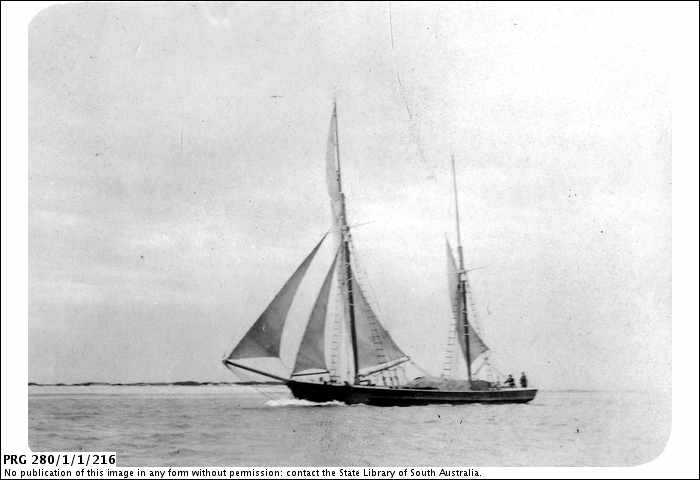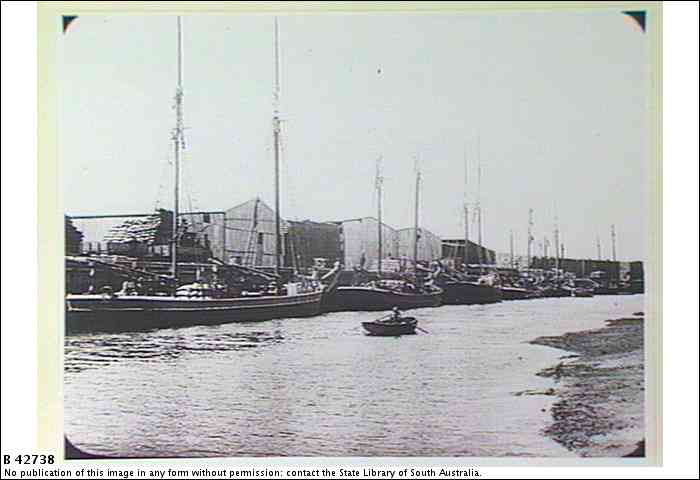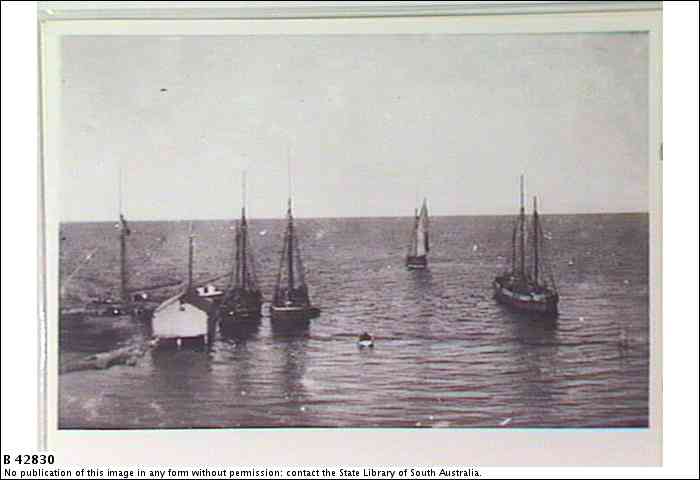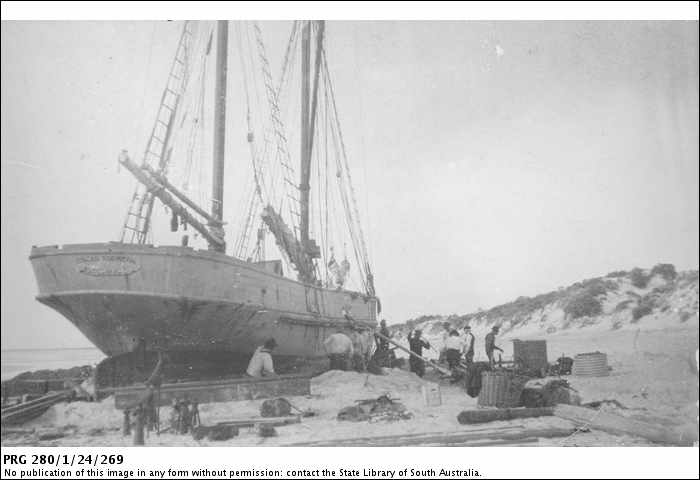Suggest a topic
Suggest a new Did you know? topic

Coastal shipping
891 ABC Afternoon Delights at the State Library : 10 May 2005
Carole Whitelock talked with Michael Talbot
One bay in the Mortlock Wing Exhibition is about shipping -- Wooden walls and iron sides. It covers the international shipping that brought immigrants to the state and shipping on the Murray. This month's topic is about the third aspect of the bay, the coastal shipping that played such an important part in the earlier development of the state.
State Library collections
The State Library has a strong collection of shipping photographs, many of them viewable through the Library's catalogue
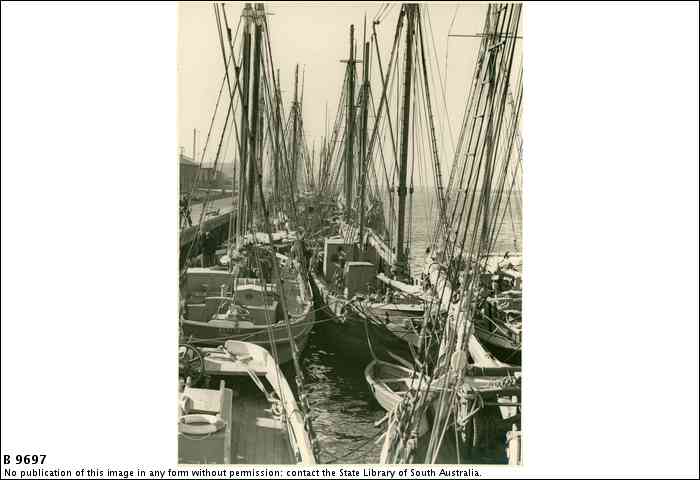 B 9697- Ketches, Birkenhead, 1937
|
Books about the vessels themselves include Ketches of South Australia : a record of small sailing ships on the coast of South Australia, 1836-1970 by Ronald Parsons, and South Australian coastal shipping industry, 1836-1972 : a general survey by Kerron Gillen, Thesis (BA Hons. 1972), University of Adelaide.
Ron Thiele's Ketch hand: the twilight of sail in South Australian waters is an entertaining read. Ron was born in 1926. He started in ketches not long after leaving school and spent the next twenty years at sea.
On exhibition from the Archival collections are some items associated with the ketch Prima Donna. One of its cargo books provided the inspiration for the background to the window - examples of the kind of freight carried. A letter from the captain at Port MacDonnell to his wife from August 1880 is a reminder of the perilous nature of the sea. He wrote of a week-long storm, and after he left Port MacDonnell his ship disappeared and was declared lost at sea.
Photographs of South Australian lighthouses and a map from 1883 showing the location and patterns of the beams of SA lighthouses are an indication of the measures taken to increase the safety of coastal shipping.
South Australia was conducive to coastal shipping
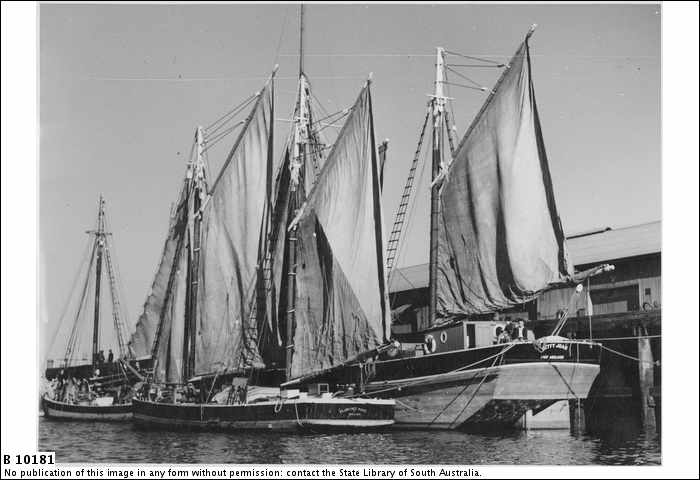 B 10181 - Ketches, Port Adelaide, 1938 |
There are ports or landing places from Port MacDonnell in the south east to Fowlers Bay in the west. Gillen's thesis on the South Australian shipping industry lists 94 shipping places on the South Australian Coast. Twelve of them are on Kangaroo Island; 11 are west of Port Lincoln and seven to the west of Cape Jervis. The remaining 64 are on the coast of Spencer or St Vincent Gulf.
The geographical features of the two gulfs partly sheltered by Kangaroo Island was conducive to small vessels and a large-scale coastal trade. There were few large harbours but the many smaller ones allowed coastal vessels to move goods to and from minor ports and the surrounding country.
The coastal fleet
Between 1836 and 1970 there were some 330 vessels employed in the SA coastal trade - 277 of them were sailing vessels of various kinds. The most common kinds of were ketches (96), schooners (85) and cutters (67). Small vessels such as these needed the least labour to run them, a crew of three being common.
The coastal fleet peaked at 112 in 1880 but exceeded 40 from 1865 to 1945. There were still six in operation in 1970 - the motor vessels Acolade, Troubridge, Ulonga and Nelcebee, and two sailing ships, the One and All, and the Falie. The largest number of vessels in the coastal fleet were ketches - two masted ships with the main mast towards the front and a shorter mast towards the stern.
In the early period various factors impacted on the number of ships. The 1860-1875 period saw the Wallaroo and Moonta mines peak in their production. Changes to legislation helped break up the large pastoral properties on the peninsulas and led to an increase in settlement and the number of ports and landing places. Railway growth before 1879 consisted of eight unconnected systems that connected inland regions with the coast. Single line examples would be Mt Gambier to Beachport, or Naracoorte to Kingston. A more extensive network linked inland places like Snowtown, Moonta, Blyth, Hoyleton, Halbury and Balaklava with Port Broughton, Port Hughes, Port Arthur and Port Wakefield. Because there was easier transport into the inland, there was an increase in the amount of cargo available for ships.
Powered vessels were the first to force sailing vessels out of the more lucrative trades. Railways had initially favoured the shipping industry, became competitors when individual lines were linked up to form a network. With cars and trucks came roads which made land communication easier and led to the obsolescence of most of the smaller ports.
After the peak, numbers fell owing to steamships and then railways taking away from the trade. The growth of motor traffic after about 1915 also contributed dramatically.
Regional shipping companies
The Port Wakefield Shipping Company was one of a number of regional shipping companies. This photograph from about 1910 shows the extent of the wheat trade leaving Port Wakefield.
The Port Pirie Shipping Company was another. It controlled the schooners Experiment, Dianella and Maldon Lewis.
Cargoes
Ron Thiele remembered that crews described ships by capacity rather than their tonnage - the Tickera as about 860 bags or the Hawk as about 1,500. This gave a crude indication of size, and more importantly a measure of the amount of work in loading and unloading.
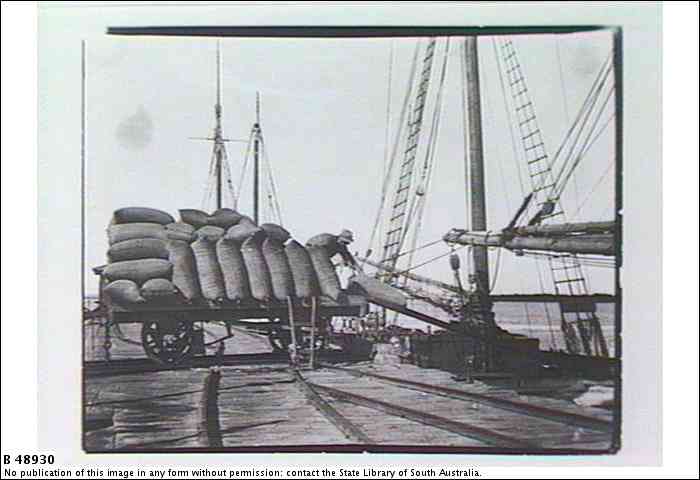 B 48930 - Loading wheat, 1928 |
Bags contained wheat, barley or salt, the usual ketch cargoes. A common practice was to 'bleed' bags by slitting them, to force them in under the deck. During unloading a 'needle boy' had the job of stitching up split bags. Spilt grain from the hold was also bagged and stitched closed.
There were occasional cargoes of fertilizer, chaff, firewood or bulk gypsum. The last was an unpopular cargo. Although it was loaded from a chute in Stenhouse Bay, unloading was hard manual work - shovelling the gypsum into steel buckets, which were hoisted out of the hold by the ship's friction winch.
At some destinations there was no wharf or jetty and ships had to moor and either transport cargo by boat or wagon from the shore. At other places the ship might be beached.
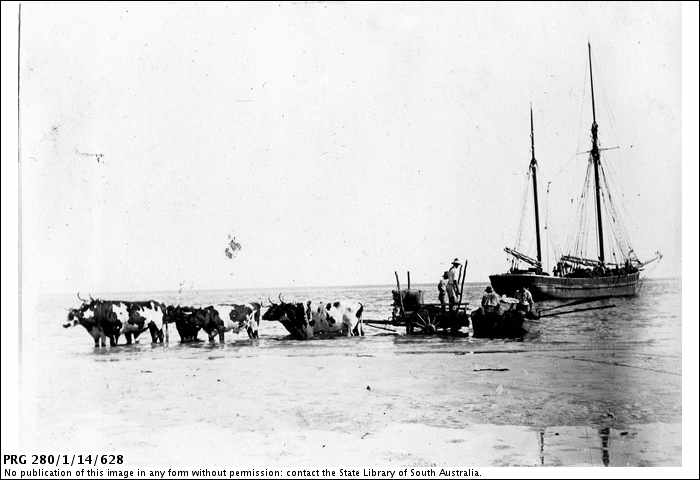 PRG 280/1/14/628 - Bullocks and cart standing in sea waters, 1913 |
Dwindling fleet
As opportunities for employment dwindled in the early 1950s sailing ships were sold off - some to continue useful careers in other places. The Claire Crouch, for example, was renamed and as the Booya had a fishing career off the Northern Territory until it was lost in Darwin Harbour during Cyclone Tracy, in December 1974.
Others were bought by people lacking experience with small and older sailing vessels. New owners tended to put too much reliance on old auxiliary engines. The ketch Lurline was built in Hobart in 1873 and owned and sailed by one skipper from 1903 until 1946. Two ex-steamship officers bought the Lurline which was wrecked at Sellicks Beach the day after leaving Port Adelaide for Victoria.
The last two working vessels of the South Australian ketch fleet were the Nelcebee (built 1883) and the Falie (built 1919). They operated a freight service to Kangaroo Island until June 1982.
During 1986 the Falie participated in a re-enactment of the grain trade, calling at 35 former ketch ports. It is still preserved and runs cruises.
More Afternoon Delights
ABC Afternoon Delights at the State Library is a series in which Carole Whitelock talked with Michael Talbot from the State Library about South Australian topics, illustrated by items from the Library's collections. View the associated SA Memory page for each topic in the Did you know? section of the website.


